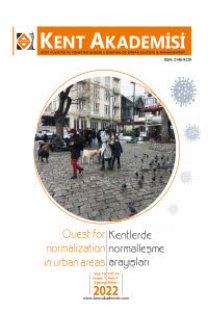Kentsel Dönüşümde Bir Senaryo: Kentsel ve Sosyal Altyapı Parametreleri
Kentsel dönüşüm uygulamaları için kurgulanmış olan bir matematiksel model çerçevesinde yeni yapılacak ya da yapılması planlanan kentsel dönüşüm çalışmalarında izlenmesi gereken yol ve yöntemlere ilişkin hesap ve değerlendirmelere katkı sunmaya çalışan bu makale; deprem kaynaklı bir riskli yapı çalışması yerine, ulusal ve uluslararası standartlar ve öneriler ışığında, alan temelli bir planlama çalışmasına yardımcı olmaya, planlamanın, mimari düşüncenin, mühendislik parametrelerinin ve çevresel etkilerin bir araya getirilmesiyle bir yapı oluşturarak bir Tasarı Kentsel Dönüşüm Modeli (TKDM)’nin Kentsel ve Sosyal Altyapı Parametrelerini düzenleyici bir öneri getirmeye çalışmaktadır.
Anahtar Kelimeler:
Kent, matematik model, kentsel dönüşüm, sosyal altyapı
A Case Study in Urban Transformation: Parameters of Urban and Social Infrastructure
Within the framework of a mathematical model designed for urban transformation applications in this article, it is tried to contribute to the accounts and evaluations related to the methods to be followed in the new urban transformation studies. This paper aims to create a structure by combining planning, architectural thinking, engineering parameters and environmental impacts in a field-based planning study in the light of national and international standards and recommendations, rather than an earthquake-based structure study. The model that emerged as a result of this study was called as Draft Urban Transformation Model (DUTM) and a suggestion is made a regulatory proposal for Urban and Social Infrastructure Parameters.
Keywords:
City, mathematical model, urban transformation, social infrastructure,
___
- [1] Tzoulas, K. at all, (2007). Promoting ecosystem and human health in urban areas using Green Infrastructure: A literature review, Landscape and Urban Planning, (81), 3, 20, P.167-178.
- [2] Munda,. G., (2006). Social multi-criteria evaluation for urban sustainability policies, Land Use Policy 23 (2006) 86–94.
- [3] Couch, P. ve Fraser, C. (2003). Urban Regeneration in Europe, Blackwell. Çavuşoğlu, E. (2011). İslamcı Neo-Liberalizmde İnşaat Fetişi ve Mülkiyet Üzerindeki Simgesel Hâle. Birikim, 270, 40-51.
- [4] Lesh , R.A., & Doerr, H. (2003). Foundations of model and modeling perspectives on mathematic teaching and learning. In R.A. Lesh and H. Doerr (Eds.), Beyond Constructivism: A models and modeling perspectives on mathematics teaching, learning, and problem solving. Mahwah, NJ: Lawrance Erlbaum.
- [5] Lingefjard, T. (2002). Teaching and assessing mathematical modeling. Teaching Mathematics and Its Applications, 21 (2), 75-83.
- [6] Borromeo-Ferri, R. (2006). Theoretical and empirical differentiations of phases in the modelling process. Zentralblatt für Didaktik der Mathematik-ZDM, 38 (2), 86-95.
- [7] Polat, H. İ., (2017), “A Mathematical Model Suggestion for Urban Transformation in Turkey - Türkiye’de Kentsel Dönüşüm Uygulamaları İçin Matematiksel Bir Model Önerisi”, Yıldız Technical University, Institute of Science, Istanbul.
- ISSN: 2146-9229
- Yayın Aralığı: Yılda 4 Sayı
- Başlangıç: 2008
- Yayıncı: Karadeniz Yazarlar ve Şairler Derneği
Sayıdaki Diğer Makaleler
Kentlerin Tarihi ve Kültürel Dokusunun Korunması Bağlamında Kentsel Dönüşüm Uygulamaları
Yapay Zekâ Kullanımının Sanata Etkileri
Pınar KIRKIK AYDEMİR, Burak Kaan YILMAZSOY, Bilgehan AKYÜZ, Çiğdem AKDEMİR
Kentsel Alan Kullanımlarının Zamansal Değişimlerinin Hava Kirliliği Üzerindeki Etkisi
Coğrafi Bilgi Sistemleri İle Taşkın Tehlike Haritalarının Belirlenmesi
Gül USLU, Faik Ahmet SESLİ, Bayram UZUN
Melisa Elif İLHAN, Handan ÖZSIRKINTI KASAP
Tarihin Yaşayan Şahidi: Çiğ Gölü (Mesudiye, Ordu, Türkiye)
“Acele Yok Arkadaş” İnsanın Yere Bağımlılığa Meydan Okuması
